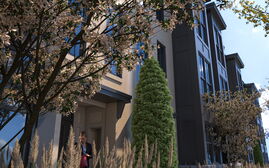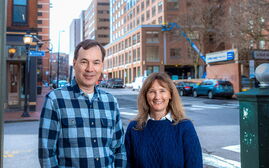How developers are remaking a former hospital site to suit a historic Portland neighborhood
Contractors are hard at work on the multi-faceted redevelopment of a former hospital in Portland’s West End.
Under the aegis of NewHeight Redfern — a joint venture between two Portland development firms, NewHeight Group and Redfern Properties — the former Mercy Hospital at 120 State St. is being transformed into 165 rental apartments and ground-floor commercial spaces.
It will be called the Nightingale, in honor of Florence Nightingale, considered the founder of modern nursing.
Around the corner, across Spring Street, nine townhouses — called Winter Street Townhomes — are under construction.
A turn at the next corner onto Winter Street finds two affordable housing developments underway as joint projects of nonprofits Community Housing of Maine and the Portland Housing Authority.
Over 100 units in the Mercy Hospital building will be available in October. The rest are due to open in January.
“We have a long list of people excited to move in here,” says Jonathan Culley, Redfern’s co-founder and managing partner.
Although still to be erected, six of the townhouses have already sold.
Puzzle pieces
The Nightingale, a short walk from downtown, is surrounded by tree-lined streets with vintage homes. In selecting projects, Redfern’s considerations range from broad to specific — from creating quality apartments in Portland’s most walkable neighborhoods, to the nitty-gritty of apartment layout in a certain footprint.
NewHeight principal Chip Newell has been in real estate development for over 30 years.
“I like things that aren’t easy,” he says with a laugh.
He continues, “This was a puzzle. It was a big hospital, it had a good bit of land, it had two floors that were underground and dark. How do you come up with the best possible redevelopment for that?”
NewHeight’s other principal, Erin Cooperrider, picks up the discussion.
“This site and this project will have big positive impact on this neighborhood,” she says.
That means things like more people in the neighborhood, the addition of small businesses and provisions for public and alternative transportation, including the addition of a bus stop at the site and storage and parking for up to 100 bicycles.
Adds Newell, “And there won’t be ambulances at 2 o’clock in the morning anymore.”
Historic fabric
The project helps meet Portland’s need for housing of all types, says Christine Grimando, the city’s director of planning and urban development.
“The fact that it’s bringing a new infusion of housing, and other uses, is always welcome in the city,” she says. “The fact that we’re also getting redevelopment of and repurposing of some of the campus is great, too.”
Grimando notes that new construction and redevelopment projects can be challenging for neighborhoods, particularly for direct neighbors. In this case, “I think the developers have been thoughtful about mixing old and new and working with the historic fabric there. That seems to be of great value for helping to transition that site into something new and giving it new life,” she says.
“I think that, ultimately, it was done with a good amount of consideration of public input. And planning staff here, in consultation with the development team, worked hard to make sure, through zoning changes and considered design, the project fit well into the surrounding context.”
WWII-era building
Mercy Hospital’s eight-story building dates to 1943. Northern Light Health acquired Mercy in 2013. In 2018, with plans to consolidate Mercy’s operations at its Fore River campus, Northern Light Health requested proposals for redeveloping the State Street campus.
NewHeight Group and Community Housing of Maine partnered to submit their successful proposal and teamed up with Redfern Properties to buy the campus in 2020, leasing it back to Northern Light for two years while pursuing plans and permits. Zachau Construction of Freeport began work on the Nightingale in early 2022.
The original campus included 250,000 square feet of buildings. About 50,000 square feet of one-story structures along Winter Street were demolished, leaving 200,000 square feet in the main building for conversion. The project includes parking areas and a landscaped pedestrian plaza and walkway.
Ninety percent of the units will be rented at market rates from $1,500 to $2,800 for studios to one-bedrooms. The rest is designated as workforce housing, with rents based on 100% of area median income.
Diversacorp, a construction firm in Saco, is building Winter Street Townhomes.
Ryan Senatore Architecture in Portland drew up designs for both projects. The $65 million historic redevelopment is financed by state and federal historic tax credits, private equity and a construction loan from Bar Harbor Bank & Trust. The Genesis Fund, with CEI Inc. and Mercy Community Capital, is providing bridge financing.
Neighborhood meetings
Throughout the proposal process, NewHeight Redfern met with neighborhood residents for their input. Although residents were generally supportive of new housing, “There were a lot of concerns about what it would look like, what the traffic would be like,” says Cooperrider.
Discussions yielded design pointers such as variations in the townhouse facades to lend visual interest along Winter Street, and the addition of street trees and front stoops.
Overall, the project is expected to lend itself to a quieter neighborhood than the hospital did.
“When you think about the intensity of traffic 24/7, the emergency room, sirens coming and going all night long and the equipment on the roof — we took down three huge chillers — even the construction noise has been less than that,” says Cooperrider.
Historic columns
PBC Environmental, a demolition and environmental abatement contractor in Kittery, worked for five months to take down Mercy’s ambulatory wing, which included the former hospital’s emergency department on Spring Street.
The removal generated 480 tons of metal and 3,668 cubic yards of concrete and masonry sent out in 312 truckloads for recycling. Work on the interior of the remaining structure included environmental abatement and demolition and removal of the building’s 200,000-square-foot interior, down to the concrete structure.
The team uncovered historic elements such as decorative columns and carvings from an old chapel, hidden above ceilings, in walls and under floors. Nearly 70 workers, supervisors, engineers and project managers worked to surgically dismantle, expose, preserve and protect them.
In the lobby, Cooperrider points out vintage columns — concrete and faced with a wood veneer decorated with diamond patterns at the top — discovered when the walls were opened up. New veneer will be installed and the columns will remain exposed. The terrazzo floor and terracotta walls will also be preserved.
Dark space
One challenge was the building’s two subterranean levels, comprising 40,000 square feet of “dark space” unsuitable for residential use.
Instead, NewHeight Redfern will create a self-storage business and numerous amenities, including a large co-working suite with its own door to the outside, a yoga room, library, billiards and game room, large package room and bicycle storage.
A “woonerf” — a Dutch term for shared street space — will serve as a plaza and pedestrian way with seating, greenery, trees and patio pavers. The goal is to fill the adjacent commercial spaces with friendly neighborhood spots.
“We’re trying to create placemaking through lively businesses,” says Culley. “We’re hoping for an all-day restaurant, café, bakery — that kind of thing. We’ve got a French chocolatier moving into the middle suite.”
Energy-efficient
From the building’s top floor, the view from the “sky lounge” and roof deck includes the ocean and even Mount Washington on a clear day, says Cooperrider. A large kitchen and family-style dining room will be available for tenants.
Overall construction includes new windows, new insulation and all-electric variable refrigerant flow technology with heat pumps throughout.
“We’ll go from a not very energy-efficient building to extremely energy-efficient,” says Culley.
Based on his experience with Redfern’s other development projects, Culley says he expects a wide range of renters.
“We get young professionals,” he says. “We also get older people who want to live in an elevator building, people who have sold their homes — I call them renters by choice. We get a wide range of people in a wide range of professions and a wide range of ages.”
In-migration
The project lends itself to the trend of people relocating from larger urban centers to Portland, he continues.
“Particularly since COVID started, there’s been a ton of in-migration,” Culley says. “Most of the tenants in our other buildings are new to Maine. They’re coming from New York, Boston, California.”
Culley notices several primary drivers of in-migration, including the ability to work from home.
“People don’t necessarily have to live where their jobs are anymore,” he says. “That will continue. And there’s climate migration. People are leaving California because the smoke is unbearable, or leaving someplace because the heat is too much. We’re seeing a lot of that and I think that trend will continue.”
He adds, “The market is extremely tight, so we’ve got to keep building.”

















0 Comments